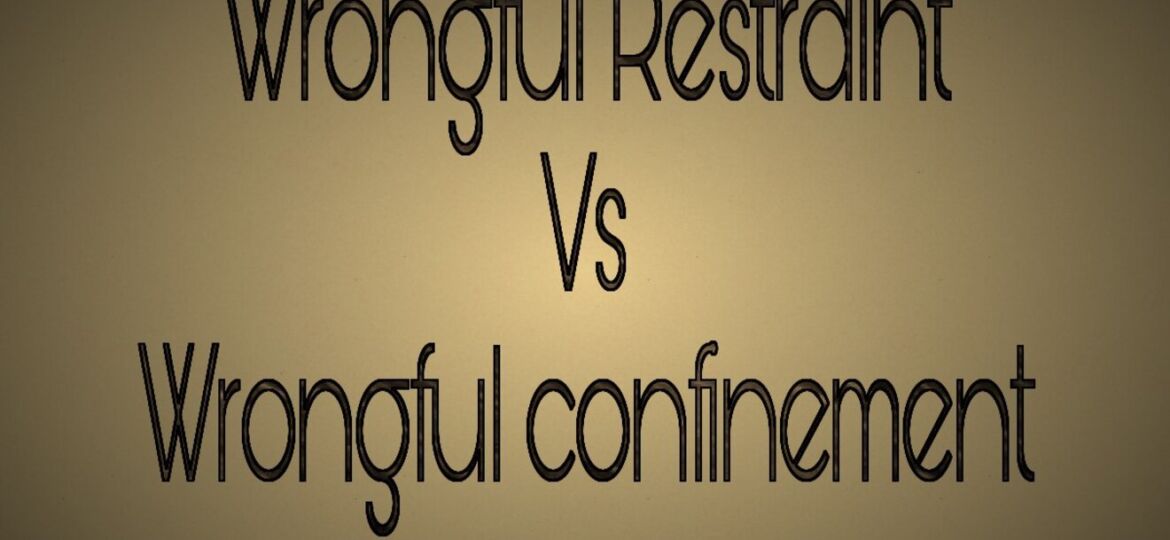
INTRODUCTION
Universal Declaration of Human Rights, Article 13(1) states “Everyone has the right to freedom of movement and residence within the borders of each state.” The Constitution of India provides its people with Article 19(Right to Freedom) and Article 21(Right to Life and Liberty) under which, no one can be forced to not move around the country as they please unless prescribed by law.
The phenomenon of stopping a person from being able to move around freely in the country as they wish to (unless under the belief of good faith or legal authority) can be classified into Wrongful Restraint, Wrongful Confinement, and False Imprisonment. The terms can often be misinterpreted or used interchangeably but all three of these violations have different significances under law.
WHAT IS WRONGFUL RESTRAINT?
The term ‘restraint’ as explained by the Oxford English Dictionary, means “a measure or condition that keeps someone or something under control”. As further elaborated in Section 339 of the Indian Penal Code, “Whoever voluntarily obstructs any person to prevent that person from proceeding in any direction in which that person has a right to proceed, is said wrongfully to restrain that person.” To put it in a simpler manner, wrongful restraint essentially means blocking someone from going to one place from the other without any legal justification. The only exception to this provision is if a person believes in good faith that they have the ability to obstruct someone’s way, or if the way passes through private property.
Wrongful restraint is not considered as serious or grave as the others because it is only partial restraint and not total restraint of the person to move, just one direction which is blocked. One must also remember that blocking the path or direction does not mean that only physical obstructions are valid, but any threat to the Right to Freedom of Movement will be considered as wrongful restraint.
The punishment for wrongful restraint as stated in Article 341 of the IPC is imprisonment up to a month or compensation of ₹500 or both; as was also mentioned in the cases Keki Hormusji Gharda And Others v. Mehervan Rustom Irani And Another, Lalloo Pd. vs Kedarnath Shukla And Anr. on 4 December 1962, Venu Alias Venugopal And Others v. the State Of Karnataka . and others.
WRONGFUL CONFINEMENT – WHAT DOES IT MEAN?
The Cambridge English Dictionary defines ‘confinement’ as “the situation in which a person or animal is kept somewhere, usually by force“. Section 340 of the India Penal Code covers Wrongful Confinement and explains it as “Whoever wrongfully restrains any person in such a manner as to prevent that person from proceeding beyond certain circumscribing limits, is said “wrongfully to confine” that person.” To give a basic illustration, Person A locks Person B in a room with no means to escape, or places armed men who might fire at Person B if they move beyond a certain point. In this case, Person B is allowed to move in whichever direction they want but they cannot move beyond a particular distance. This factor is what differentiates wrongful confinement from wrongful restraint.
Unlike the previous breach of the right to freedom of movement, wrongful confinement is total restraint because the person has a just limited or no space to move. Wrongful confinement has its variations, and the aggravated forms of it are elaborated further in the coming Sections 343-348 of the IPC. It has a wide ambit, but this provision has some necessary ingredients to validate the claim for wrongful confinement.
Going back to the illustration, if in this case, Person B does not wish to move out of the room or has voluntarily consented to be confined in the space, they cannot claim wrongful confinement. In front of the court, the time period of this confinement, or the physical proof of confinement is immaterial but is considered a graver crime than wrongful restraint.
The punishment for wrongful confinement as stated in Section 342 of the IPC is imprisonment which may either extend to one year, a fine which may extend to ₹1,000, or both as was brought up in the case of Emperor vs Bandu Ebrahim And Anr. on 11 September 1917, M.S Sheriff, P.C Damodaran Nair v. the State Of Madras, M. Govindan, Damodaran, and the others.
HOW IS FALSE IMPRISONMENT DIFFERENT?
False imprisonment is an extension of wrongful restraint and wrongful confinement but is considered a much graver offense than the previous two. False imprisonment falls under Tort Law, and in the Indian legal system, arresting a person without convincing legal reasons is considered a violation of Article 19 and Article 21; the aggrieved party can directly approach the Supreme Court for a remedy (Under Article 32 of the constitution) or the High Court (Under Article 226 of the Constitution).
Under the writ of Habeas Corpus (which translates to have a body), if the aggrieved party or the friends and family of the aggrieved party appeal of false imprisonment, the arresting officer needs to come up with a valid and convincing reason to prove the justification of the arrest. In a lot of cases, people tend to confuse false arrest and false imprisonment, and the basic difference here is that the intent or even making of the arrest is not necessary.
The only defenses to the claim of false imprisonment can be that the arrest was indeed lawful, and was done with a valid reason or that the arrest was made on the grounds of probable causation of harm.
Here, we only talk about the ambit of Article 32 when talking about false imprisonment and the leading cases of this provision are Rudul Shah v. The State of Bihar, Bhim Singh v. The state of J&K, to name a few.
CONCLUSION
“Freedom to travel, both within and outside the confines of the territory of the State, raises important issues of personal freedom.” (Dennis Lloyd, The Idea of Law)
Wrongful restraint, wrongful confinement, and false imprisonment are all essentially violations of the right to free movement. To restrain someone from moving in either one particular direction or beyond a certain limit are both ends of the same spectrum and probable reason why these three terms are interchanged casually. Yet, it is important to know the differences between these three and to be aware of the punishments which all three carriers.
Author(s) Name: Shivanshika Samaddar (National Law University, Delhi)
Reference(s):
- https://www.icj.org/international-year-of-human-rights-report-conclusions-of-the-conference-of-jurists-on-right-to-freedom-of-movement-bangalore-india-january-10-14-1968/
- https://www.stimmel-law.com/en/articles/false-imprisonment-legal-action
- https://blog.ipleaders.in/restraint-confinement/
- https://blog.ipleaders.in/false-imprisonment-in-tort/
- https://www.srdlawnotes.com/2017/03/distinction-difference-between-wrongful.html
















